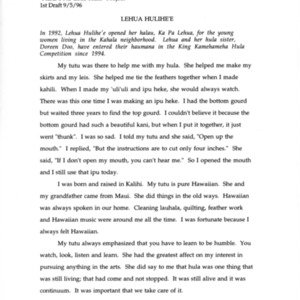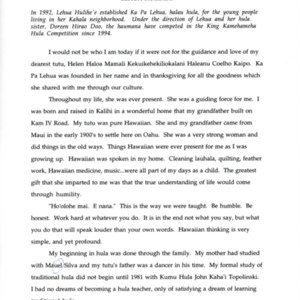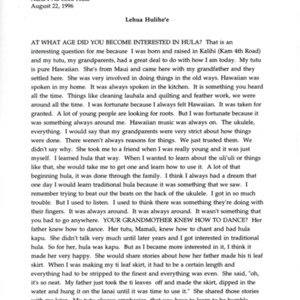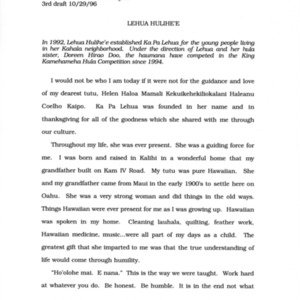Lehua Hulihe‘e
Title
Lehua Hulihe‘e
Subject
Nā Kumu Hula Lehua Hulihe‘e - Nānā I Nā Loea Hula Volume 2 Page 41
Description
Lehua Hulihe‘e established Ka Pā Lehua in 1992 and teaches hula in her home in Kahala.
I would not be who I am today if it were not for the guidance and love of my dearest tutu Helen Haloa Mamali Kekuikehekiliokalani Haleanu Coelho Kaipo. Ka Pā Lehua was founded in her name and in thanksgiving for all the goodness which she shared with me through our culture.
Throughout my life, she was ever-present. She was a guiding force for me. I was born and raised in Kalihi in a wonderful home that my grandfather built on Kam IV Road. My tutu was pure Hawaiian. She and my grandfather came from Maui in the early 1900s to settle here on O‘ahu. She was a very strong woman and did things in the old ways. Things Hawaiian were ever-present for me. Hawaiian was spoken in my home. Cleaning lau hala, quilting, feather work, Hawaiian medicine, music...were all part of my days as a child. The greatest gift that she imparted to me was that the true understanding of life would come through humility.
“E ho‘olohe mai. E nānā (Listen. Watch). This is the way we were taught. Be humble. Be honest. Work hard at whatever you do. It is not what you say but what you do that will speak louder than your own words. Hawaiian thinking is very simple and vet profound.
My beginning in hula was done through the family. My mother had studied with Manuel Silva and my tūtū’s father was a dancer in his time. Like most children I took lessons informally from my aunty. When I was older my tūtū took me up to Papakōlea Park to take lessons from my uncle George Holokai. There were many students and if you didn’t listen carefully...‘auwē! My formal study of traditional hula did not begin until 1981 with kumu hula John Kaha'i Topolinski. I had no dreams of becoming a hula teacher, only of satisfying a dream of learning traditional hula.
Hula in traditional hālau was to become a large part of my life for many years. I began in a class of seventy-five students. Within a month the class of ‘81 which had begun with seventy- five students was down to thirty and by Christmas there were fifteen...fifteen strong! We were to become friends in hula. The class of ‘81 was to enjoy another three years together before marriage, babies, and jobs would send us in different directions. The memories of this time in hula, I will always cherish.
My first years of hula focused on the feet. From August to April basic steps were taught. The steps were to be mastered before any other learning. It was quite like building a house. The foundation (the basic steps) was the beginning. Hand movements would follow. Hula practice was a constant repetition. It was a time of learning and realization. One might say that the awareness of the physical, emotional, and mental bodies is heightened through hula.
I enjoyed my teacher’s style of hula. It always amazed me how something that looked so simple could be so hard to learn. To master the style of hula taught in Ka Pā Hula Hawaiʻi took more than just Saturday classes. It is a style that you continually had to work at because it took physical stamina, grace, and poise.
I was an alaka'i for eight years before being released in 1992 (hu‘elepo). As alaka‘i in Ka Pā Hula Hawaiʻi much learning was done through listening and watching. You may be asked at any time to do translations, instrument making, lei, or even choreography. At the invitation of David Eldredge, Punahou School s advisor for the Holokū Pageant, our kumu asked Doreen Doo and I and our fellow alaka'i to instruct the students for Punahou’s May Day program and the high school competition. This was a challenge and joy and great opportunity that I am ever grateful for. Doreen and I have taught hula at Punahou School for the past eleven years. I believe that all of these experiences have helped me to learn that there is so much more to learn.
Possibly the most challenging of experiences in hula was when I was learning the art of chant. Kalani Akana was my hula brother and instructor. I also spent countless hours in the audio collection at the Bishop Museum. My kumu entered me in the 1985 Kamehameha Hula and Chant Competition in the chant division. It was a memorable experience. As I look back at this time in my learning, I believe it was the pleasure of learning this art that fed my desire to continue to learn. Learning for me is a constant beginning. I do not believe there is an end.
Being a teacher is a great responsibility. In one sense you are not the creator but the perpetuator. On the other hand, you can create within a traditional parameter that already exists. It is my sincere belief that as a teacher of tradition, one has I In' responsibility to be honest and forthright about what one knows and what one does not know. Doreen and I are continuously learning and we are not afraid to ask for help from our kupuna.
We are sharing the traditions of hula ‘ōlapa. We are sharing traditional values. As we grow up, we learn that these values are universal. Doreen and I, in our small way, wish to do whatever we can to share these hula traditions with our young people in hope that what they receive from this learning will enrich their lives and help them as they each travel their own paths in life.
"One might say that the awareness of the physical, emotional, and mental bodies is heightened through hula. ”
I would not be who I am today if it were not for the guidance and love of my dearest tutu Helen Haloa Mamali Kekuikehekiliokalani Haleanu Coelho Kaipo. Ka Pā Lehua was founded in her name and in thanksgiving for all the goodness which she shared with me through our culture.
Throughout my life, she was ever-present. She was a guiding force for me. I was born and raised in Kalihi in a wonderful home that my grandfather built on Kam IV Road. My tutu was pure Hawaiian. She and my grandfather came from Maui in the early 1900s to settle here on O‘ahu. She was a very strong woman and did things in the old ways. Things Hawaiian were ever-present for me. Hawaiian was spoken in my home. Cleaning lau hala, quilting, feather work, Hawaiian medicine, music...were all part of my days as a child. The greatest gift that she imparted to me was that the true understanding of life would come through humility.
“E ho‘olohe mai. E nānā (Listen. Watch). This is the way we were taught. Be humble. Be honest. Work hard at whatever you do. It is not what you say but what you do that will speak louder than your own words. Hawaiian thinking is very simple and vet profound.
My beginning in hula was done through the family. My mother had studied with Manuel Silva and my tūtū’s father was a dancer in his time. Like most children I took lessons informally from my aunty. When I was older my tūtū took me up to Papakōlea Park to take lessons from my uncle George Holokai. There were many students and if you didn’t listen carefully...‘auwē! My formal study of traditional hula did not begin until 1981 with kumu hula John Kaha'i Topolinski. I had no dreams of becoming a hula teacher, only of satisfying a dream of learning traditional hula.
Hula in traditional hālau was to become a large part of my life for many years. I began in a class of seventy-five students. Within a month the class of ‘81 which had begun with seventy- five students was down to thirty and by Christmas there were fifteen...fifteen strong! We were to become friends in hula. The class of ‘81 was to enjoy another three years together before marriage, babies, and jobs would send us in different directions. The memories of this time in hula, I will always cherish.
My first years of hula focused on the feet. From August to April basic steps were taught. The steps were to be mastered before any other learning. It was quite like building a house. The foundation (the basic steps) was the beginning. Hand movements would follow. Hula practice was a constant repetition. It was a time of learning and realization. One might say that the awareness of the physical, emotional, and mental bodies is heightened through hula.
I enjoyed my teacher’s style of hula. It always amazed me how something that looked so simple could be so hard to learn. To master the style of hula taught in Ka Pā Hula Hawaiʻi took more than just Saturday classes. It is a style that you continually had to work at because it took physical stamina, grace, and poise.
I was an alaka'i for eight years before being released in 1992 (hu‘elepo). As alaka‘i in Ka Pā Hula Hawaiʻi much learning was done through listening and watching. You may be asked at any time to do translations, instrument making, lei, or even choreography. At the invitation of David Eldredge, Punahou School s advisor for the Holokū Pageant, our kumu asked Doreen Doo and I and our fellow alaka'i to instruct the students for Punahou’s May Day program and the high school competition. This was a challenge and joy and great opportunity that I am ever grateful for. Doreen and I have taught hula at Punahou School for the past eleven years. I believe that all of these experiences have helped me to learn that there is so much more to learn.
Possibly the most challenging of experiences in hula was when I was learning the art of chant. Kalani Akana was my hula brother and instructor. I also spent countless hours in the audio collection at the Bishop Museum. My kumu entered me in the 1985 Kamehameha Hula and Chant Competition in the chant division. It was a memorable experience. As I look back at this time in my learning, I believe it was the pleasure of learning this art that fed my desire to continue to learn. Learning for me is a constant beginning. I do not believe there is an end.
Being a teacher is a great responsibility. In one sense you are not the creator but the perpetuator. On the other hand, you can create within a traditional parameter that already exists. It is my sincere belief that as a teacher of tradition, one has I In' responsibility to be honest and forthright about what one knows and what one does not know. Doreen and I are continuously learning and we are not afraid to ask for help from our kupuna.
We are sharing the traditions of hula ‘ōlapa. We are sharing traditional values. As we grow up, we learn that these values are universal. Doreen and I, in our small way, wish to do whatever we can to share these hula traditions with our young people in hope that what they receive from this learning will enrich their lives and help them as they each travel their own paths in life.
"One might say that the awareness of the physical, emotional, and mental bodies is heightened through hula. ”
Citation
“Lehua Hulihe‘e,” Nā Kumu Hula Archive, accessed December 13, 2025, https://nakumuhula.org/archive/items/show/119.








